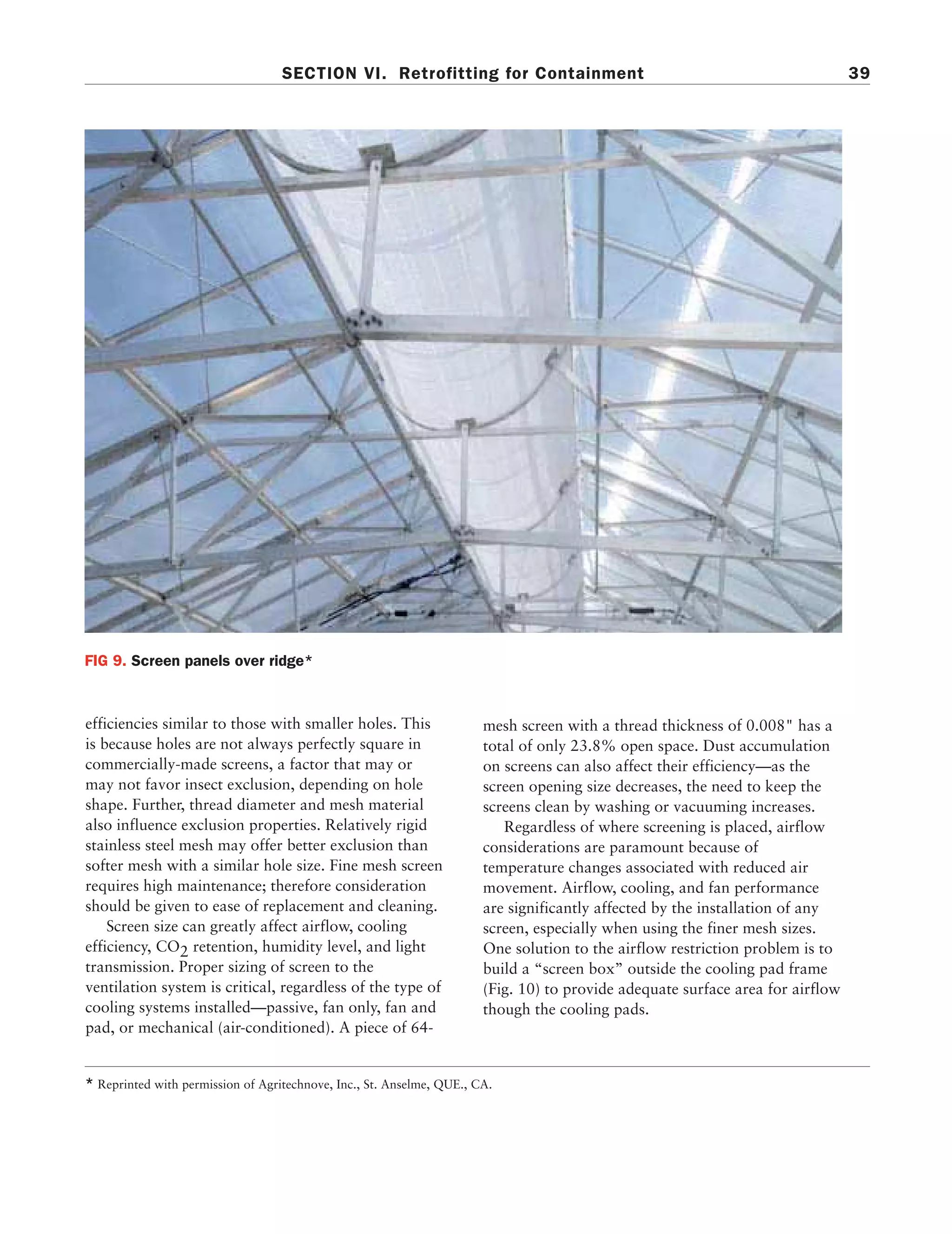This document provides guidance for conducting greenhouse research with transgenic plants and microbes. It discusses regulations for genetically modified organisms (GMOs) and outlines biosafety levels for plant research. The document emphasizes combining physical and biological containment measures to safely conduct experiments with GMOs in greenhouses. It provides best practices for access control, hygiene, signage, and more to contain transgenic materials.




![00-front matter Transgenic book 7/16/01 10:05 PM Page iv
Information Systems for Biotechnology
207 Engel Hall, Blacksburg VA 24061
tel: 540-231-3747 / fax: 231-4434 / email: isb@vt.edu
http://www.isb.vt.edu
© 2001 by Information Systems for Biotechnology
All rights reserved. Published 2001.
Printed in the United States of America.
The complete text of this Guide is available on the ISB Web site
(http://www.isb.vt.edu). Print copies are available at no charge—an
order form is available on the ISB Web site, or you may send your
request by email to isb@vt.edu or by fax to 540-231-4434. Please be
sure to include a complete mailing address.
Library of Congress Cataloging-in-Publication Data
Traynor, Patricia L., Dann Adair, Ruth Irwin
Greenhouse Research with Transgenic Plants and Microbes: A Practical
Guide to Containment/Patricia Traynor, . . . [et al.].
p. cm.
Includes bibliographical references.
ISBN: 0-9703604-0-1
1. Biotechnology. 2. Transgenic plants/organisms.
Cover and interior design by Theresa Gedig, digdesign
Printed by Sexton Printing, St. Paul, Minnesota](https://image.slidesharecdn.com/apracticalguidetoconta-120720162327-phpapp02/75/A-practical-guide-to-conta-5-2048.jpg)






























![01-07 Transgenic book 7/16/01 10:31 PM Page 25
SECTION I. Introduction 25
15
TABLE 6. Commercially important species that hybridize with wild relatives in the USA
16
CULTIVATED SPECIES WILD RELATIVE
Apium graveolens (celery) Same species
Daucus carota (carrot) Same species (wild carrot)
Chenopodium quinoa (quingua [a grain]) C. berlandieri
Beta vulgaris (beet) B. vulgaris var. maritima (hybrid is a weed)
Chicorium intybus (chicory) Same species
Helianthus annuus (sunflower) Same species
Lactuca sativa (lettuce) L. serriola (wild lettuce)
Brassica napus (oilseed rape; canola) Same species, B. campestris, B. juncea
Brassica rapa (turnip) Same species (= B. campestris)
Raphanus sativus (radish) Same species, R. raphanistrum
Cucurbita pepo (squash) Same species (= C. texana, wild squash)
Vaccinium macrocarpon (cranberry) Same species
Vaccinium angustifolium (blueberry) Same species
Trifolium spp. (clover) Same species
Medicago sativa (alfalfa) Same species
Liquidambar styraciflua (sweetgum) Same species
Juglans regia (walnut) J. hindsii
Asparagus officinalis (asparagus) Same species
Picea glauca (spruce) Same species
Avena sativa (oat) A. fatua (wild oats)
Cynodon dactylon (bermuda grass) Same species
Oryza sativa (rice) Same species (red rice)
Sorghum bicolor (sorghum) S. halapense (johnsongrass)
Amelanchier laevis (serviceberry) Same species
Fragaria sp.(strawberry) F. virginiana, F. chiloensis, others
Rubus spp. (raspberry, blackberry) Same species
Populus alba x P. grandidentata (poplar) Populus species. (ten species listed as weed
of unknown status in U.S.)
Nicotiana tabacum (tobacco) Same species (escapes cultivation)
Vitus vinifera (grape) Vitus spp. (wild grape)
15 Adapted by permission of the authors (Allison Snow and Pedro Moran Palma, Department of Plant Biology, Ohio State University) from
their publication titled "Commercialization of Transgenic Plants: Potential Ecological Risks." Bioscience (1997), Vol. 47, pp. 86-96.
16 This is not an exhaustive list, especially with regard to commercially important grasses and woody species, which often occur in
unmanaged populations. Also, for many cultivars the extent of hybridization with wild relatives has not been studied.](https://image.slidesharecdn.com/apracticalguidetoconta-120720162327-phpapp02/75/A-practical-guide-to-conta-36-2048.jpg)





































